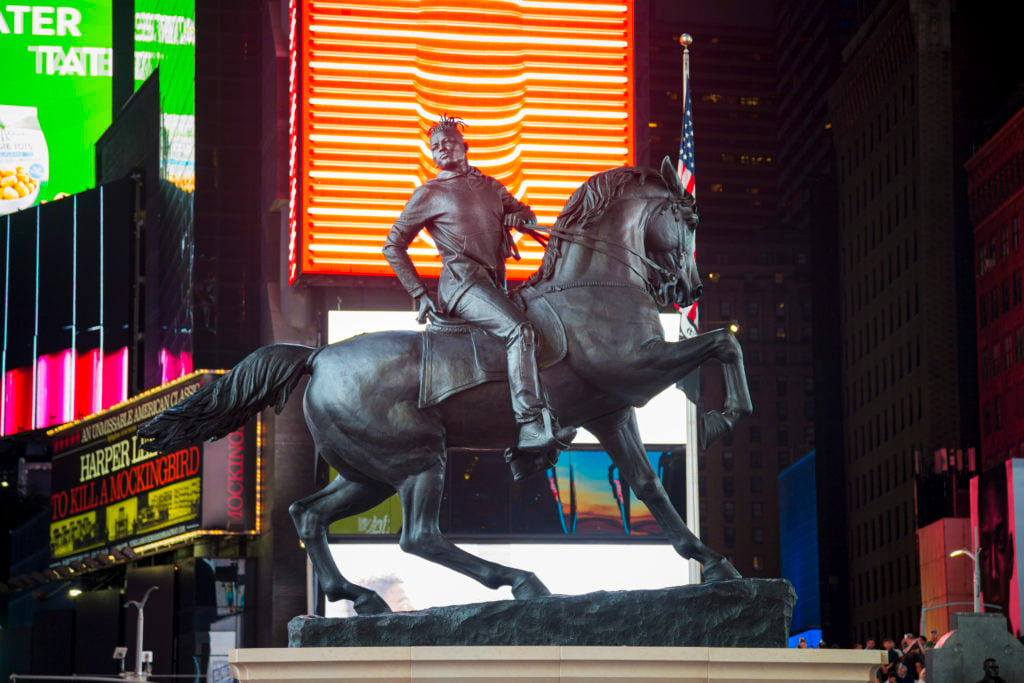Art World
This Artist Is Commandeering a Civil War Statue in New York to Celebrate the Resilience of Refugees
Krzysztof Wodiczko believes that refugees are themselves 'living monuments' to ongoing global conflicts.
Krzysztof Wodiczko believes that refugees are themselves 'living monuments' to ongoing global conflicts.
Karen Chernick

A monument to Admiral David Glasgow Farragut has been standing wordlessly in New York City’s Madison Square Park since 1881, but next month the Civil War veteran will have plenty to say. The historic Augustus Saint-Gaudens sculpture will temporarily host Monument by contemporary artist Krzysztof Wodiczko, an installation that projects videos of resettled refugees onto the larger than life-sized figure.
“With the use of projectors and projection mapping technology I am turning the silent and motionless monument into the speaking and performative monument to the refugees—the forgotten or unacknowledged civil war heroes,” Wodiczko told Artnet News.
The 30-minute video loop will be screened onto the Farragut monument every evening between January and May 2020. Wodickzo’s work shows refugees from countries such as Syria, Somalia, and Guatemala describing why they left home, describing their journeys and the difficulties of building a new life. To create the installation and connect with his subjects, Wodiczko received help from Refugee Council USA and Integrated Refugee and Immigrant Service.

Rendering of Monument by Krzysztof Wodiczko. Courtesy of the artist and Madison Square Park Conservancy.
The Farragut statue was New York’s first Civil War monument, and stands on a semi-circular platform designed by architect Stanford White. Among other things, Farragut was famous for yelling “damn the torpedoes” as his troops battled Confederate forces at Mobile Bay, and releasing New Orleans from Confederate control.
Though Farragut stood on the right side of history, Wodiczko’s installation challenges the notion of who is worthy of public monuments. The very term monument, he explains, comes from words “that mean a warning, and to be mindful.“ He thinks of the 70 million refugees around the world today as their own sort of “functional monuments,” in human form.
Wodiczko, who is the head of the Interrogative Design Group at Harvard University’s Graduate School of Design, has realized over 90 public projections and installations around the world that often bring marginalized communities to the forefront. Some of his previous projects have involved projecting images of Hiroshima bombing survivors in Hiroshima Peace Memorial Park, and overlaying Vietnam and Iraq war veterans onto an Abraham Lincoln monument in New York’s Union Square.

Kehinde Wiley, Rumors of War (2019). © 2019 Kehinde Wiley. Courtesy of the Virginia Museum of Fine Arts, Times Square Arts, and Sean Kelly. Photo: Ka-Man Tse for Times Square Arts.
This project, Monument, joins a larger national conversation about how we should address Civil War monuments today, specifically those memorializing Confederate figureheads. In September, artist Kehinde Wiley unveiled Rumors of War—a monumental equestrian statue of a young African American man that was exhibited in Times Square before beking transferred to Virginia, where it is now permanently installed within the vicinity of Confederate monuments.
This month, the Texas Senate formed a special committee to decide how it should handle multiple painted portraits of Confederate figures (including Confederate president Jefferson Davis, which hangs next to the presiding officer’s desk in the state’s Senate Chamber). Meanwhile, a Republican representative in Tennessee has a proposition for what to do about his state’s monument to Confederate general and first Grand Wizard of the Ku Klux Klan, Nathan Bedford: replace it with a statue of Tennessee-born musical idol, Dolly Parton.
Wodiczko’s project demonstrates, though, that monuments to figures whose history is not contentious can still be used as platforms to voice contemporary concerns. “It is a time to publicly acknowledge [the refugees] for their potential contribution to the informed memory and understanding of civil wars,” he says. “As living war monuments and memorials.”